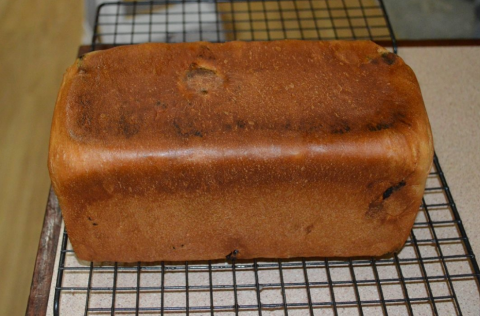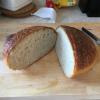Poolish or not poolish
Hello all,
I am a newbie to the forum and also a newbie bread baker, actually I shouldn't call myself a baker because I have been only baking since June '16, or 156 loaves to be exact, and the only thing I've baked so far is baguettes. So to clarify, I am just a newbie period!! I am still struggling with my dough handling and scoring; things seem to happen right only some of the times.
Since I was first exposed to baking baguettes I have tried quite a few different recipes and methods, from few hours no kneed to two day bake process. Because of my inconsistency, too often my wife would say that there is little differences in results among methods I choose. I recently came across an article in this forum by Janetdo, where she mentioned Anis Bouabsa (http://www.thefreshloaf.com/node/8066/great-baguette-quest-n°3-anis-bouabsa), who did not use a prefermenter. For the sake of efficiency, I want to bake quick and still get a good quality bread so comes this post- pretty much a comparison between a 36 hour poolish and non poolish recipe with various fermentation times. I am also hoping to get some critics to learn more from people in the forum about making baguette.
Recipe:
. 500 g AP Ardent Mills (first time use)
. 375 ml water
. 10 g salt
. 1/4 tsp SAF
Note: for poolish: 150g of the 500g was mixed in 150ml water with 1/16 tsp of yeast
Method:
Poolish: 12 hours poolish at RT; mix poolish with remaining ingredients then slap and fold 3 times every 30'; refrigerate for 18hrs, 20hrs, 22hrs @ 43F; preshape approximately 2 loaves of 150g each for 60'; shape for 45'; bake at 490 for 12' and 460 for 8'.
Non-poolish: Mix ingredients then slap and fold 3 times every 30'; refrigerate for 18hrs, 20hrs, 22hrs @ 43F; preshape approximately 2 loaves of 150g each for 60'; shape for 45'; bake at 490 for 12' and 460 for 8'.
The cold fermentation for both groups started at the same time in the same refrigerator.
Results:
After the long refrigeration time the poolish dough (right) was noticeable more in volume but it was not as smooth as its counterpart. The polish dough was more bubbly and rougher where as the non poolish was smooth and glossy. The non poolish also felt denser and more compact when handled but both seemed to have the same level of elasticity, hardly any noticeable differences when stretched.

The first batch came out underbaked, I therefore increased the bake time to a little longer than 23'. That resulted in batch #2 which was a little on the burnt side. Batch #3 bake time was about 22'.
The poolish batches appeared to have better oven spring, except loaf #10 (batch #3, 22hrs). I am not quite sure what happened in this batch but the non poolish loaf #12 also looked very deformed. I can only guess that bad handling was the cause because timer was going off everywhere and I was rushing or perhaps 22 hrs was a too long of a fermentation process? The crumbs also seemed to be denser in batch #3 except for loaf #9, a result that completely surprised me because I was expecting these loaves to be the best looking of all. The #10, #11, and #12 were the most inferior looking in the entire experiment. I could not say that they were under proofed or under baked because #9 did not exhibit any of those problems; It is another baking mystery to me, may be someone can point out the possibilities.
Batch descriptions:
Batch 1 (top row, 18hrs): 2 loaves of poolish (#1, #2) and 2 loaves of non poolish (#3, #4)
Batch 2 (middle row, 20hrs): 2 loaves of poolish (#5, #6) and 2 loaves of non poolish (#7, #8)
Batch 3 (bottom row, 22hrs): 2 loaves of poolish (#9, #10)and 2 loaves of non poolish (#11, #12)
Note:
loaf #2 is not in the photo, I had to make a sandwich for my daughter who was hungry and eager to leave the house.
loaves #5 and #6 were a little undersize- they were about 125g.
Note: the image below was rotated 90 counter clockwise when it was uploaded and I couldn't find the way to fix the problem. So, column #1 in the image is actually Row #1, loaf #1 is at bottom, loaf #4 is on top. Column #2 is middle row, loaf #5 is at the bottom and #8 is on top, so on.. The image comes after matches the batch description stated above.


I could not tell the difference between the 18hrs, 20hrs and 22hrs fermentation time among the two groups as far as taste goes, but I could tell that the poolish groups had better flavor when doing a side by side smell test. A subtle difference that I may not be able to detect if doing a stand alone taste test but it is easier when they are next to each other. That kind of bring up the thought of how Anis Bouabsa bread was rated the best??
Conclusion:
At my level, it doesn't seem to matter much which method I would choose, poolish or non poolish, since they can both yield good tasty loaves of bread. It appears that I could use a shorter fermentation time without any noticeable differences but the questions is- how much shorter. So until I become more bread snobbish I would just use whichever one that I feel like doing and bake away.

Thanks for reading and happy baking!
























